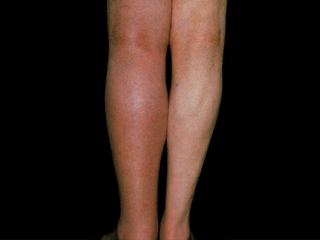A blood clot is a clump of blood that forms in a blood vessel. It is also called a thrombosis.
Blood clots can be very serious and need to be treated quickly. Staying healthy and active can help prevent them.
Types of blood clots
There are two main types of blood clot:
- deep venous thrombosis (DVT)
- pulmonary embolism (PE)
Deep venous thrombosis (DVT)
A DVT is a blood clot that forms in a deep vein, usually in your leg.
Symptoms include:
- swelling or pain in one leg or calf
- warmth or redness in a leg
You may not show any symptoms.
Pulmonary embolism (PE)
A PE is when a DVT or part of the DVT travels in the blood and becomes lodged in a blood vessel in your lungs.
Symptoms include:
- shortness of breath or rapid breathing
- chest pain, which may be worse when you breathe in
- a cough or coughing up blood
- feeling dizzy
Urgent advice: Seek medical help immediately if:
- you or someone else develops 1 or more symptoms of a blood clot
Emergency action required: Call 112 or 999 or go to your nearest emergency department (ED) if:
- you or someone else is struggling to breathe
- someone has passed out
What a blood clot in a leg can look like


Check if you're at risk of blood clots
You're more likely to get a blood clot if you:
- are staying in or recently left hospital
- are pregnant or had a baby less than 6 weeks ago
- have active cancer or you're getting cancer treatment
- cannot move 1 or both legs, for example if your leg is in a cast
- are overweight
Other things that increase your risk of clots include:
- smoking
- using combined hormonal contraception such as the pill, vaginal ring or patch
- having had a blood clot before
Preventing blood clots
If you're in hospital or at a high risk of blood clots, follow the advice of your care team about preventing clots.
This may mean you:
- wear compression stockings to improve your blood flow
- take medicine to reduce your risk (anticoagulants)
There are other things you can do to help avoid clots.
Do
-
keep moving - even if you’re sick in bed, try to move your legs and feet every 90 minutes
-
drink plenty of water to avoid dehydration - your pee should be light yellow or clear
Don't
-
do not sit for long periods without moving, if you can avoid it
-
do not drink lots of alcohol as this can make you dehydrated
More information is available from Thrombosis Ireland
